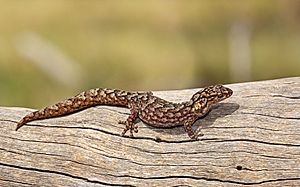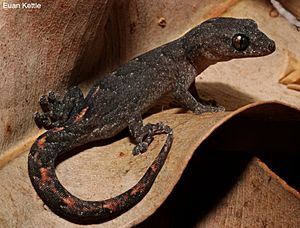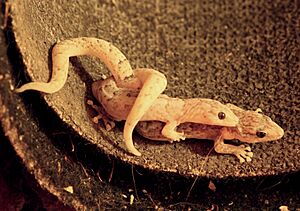Marbled gecko facts for kids
- For the New Caledonian species called marbled gecko, see Oedodera marmorata
- For the Australian genus called marbled geckos, see Christinus
Quick facts for kids Marbled gecko |
|
|---|---|
 |
|
| Scientific classification | |
| Genus: |
Christinus
|
| Species: |
marmoratus
|
| Synonyms | |
|
Phyllodactylus marmoratus |
|
The Marbled Gecko (scientific name: Christinus marmoratus) is a type of gecko found in southern Australia. You can find them from Victoria all the way to Western Australia. These geckos are super adaptable. They can live in many different places, even in cities!
Contents
How Geckos Get Their Names
The Marbled Gecko was first officially named by a scientist named John Edward Gray in 1845. He first placed this gecko in a group called Diplodactylus. Gray studied four geckos preserved in liquid to describe them.
Later, in 1885, another scientist moved the Marbled Gecko to a different group called Phyllodactylus. It stayed there until 1984. Then, a new study placed it in the group Christinus, which is where it is today.
Scientists also found that Marbled Geckos have some differences in their genetic makeup depending on where they live. Because of this, they are now split into two subspecies:
- C. marmoratus marmoratus (the Western Marbled Gecko)
- C. marmoratus dactylus (the Southern Marbled Gecko)
What Does It Look Like?
Adult Marbled Geckos are usually about 50 millimeters (2 inches) long, not counting their tail. They weigh around 2.5 grams, which is about the weight of a small coin.
These geckos store extra fat in their tails. This fat helps them survive when food is scarce. If a Marbled Gecko feels threatened, it can actually drop its tail! This is called autotomy. The wiggling tail distracts predators, giving the gecko time to escape. It takes about eight months for a new tail to grow back. New tails look a bit different from original ones. Young geckos drop their tails more easily than adults do.
Where Do They Live?
The Marbled Gecko is Australia's most southerly gecko species. This means it lives further south than any other gecko in Australia. You can find them from northeastern New South Wales all the way to southwestern Western Australia. They also live on several islands off the coasts of South Australia and Western Australia.
They live in many different places, including:
- Open shrubland (areas with small bushes)
- Sclerophyll forests (forests with tough-leaved trees)
- Woodlands near rivers
- Even in cities and towns!
Marbled Gecko Habits
Marbled Geckos are insect-eaters. They are also nocturnal, meaning they are active at night.
During hot summer days, they usually hide in deep cracks in rocks or in burrows. When the weather is cooler, they often gather together under rocks. Geckos living near rivers like to rest under the thick, peeling bark of large eucalyptus trees during the day.
It's common to find Marbled Geckos living in groups of up to 10 individuals. Most of these groups have at least one male. This is a bit surprising because many geckos are known to be territorial. Scientists think they might group together to help with mating, to be more alert for danger, or simply because they are attracted to good hiding spots.
Marbled Geckos also try to control their body temperature. They might change their posture, like flattening their body against a warm rock or lifting it up to cool down. They even seem to touch the rock with their snout first, as if checking the temperature! They do make sounds, but usually only squeak if they are being attacked.
See also
 In Spanish: Christinus para niños
In Spanish: Christinus para niños




